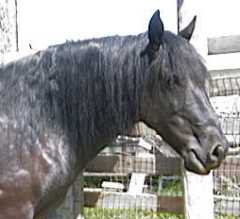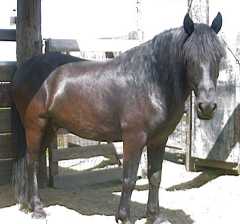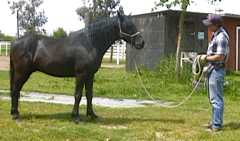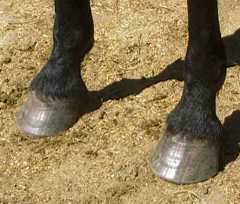KBR Horse Net
Training Case Study:
"Magnificent Max"
Part Seven
|
|
MANE DETANGLING &
MORE WITH FEET
|
|

|
|
The following day was kind of a bomb. I got held over at the
fire department most of the day so we didn't have much
time to spend with Max. We did a few foot lifts, tapping him with
the nippers and even taking a couple of small nips, but most
of the effort involved detangling his huge mane.
What we had was 6 years of natural shag and mats. Max was
already desensitized to us handling his mane but we needed
to use some detangling solution and lots of it. Sharon targeted
him on a spray bottle of Canter Silk and after getting used to
the sound of the spray while shooting it away from him, Max let her spray it on him.
|
No more tangles!

|
|
Every training effort has hills and valleys and the next day had it's
valley.
It started out started out well enough. Max was leading well inside
the pen so I opened the gate and we quietly and deliberately
ventured out into the stable. Max proceeded carefully, stopping
occasionally to sample the grass. But exploring wasn't the
primary issue today. We needed to get those long feet addressed.
|
Man, there's a lot to see out here!

|
We took Max back inside his pen. Although he had picked up his feet
without any problem in the previous session, Max refused to lift his
left front foot. I could literally bear hug his leg so he wasn't
spooky about being touched, but with every lift he would flail his
foot about as if he couldn't get his balance.
|
We went back to leg tugs and then lifting his foot with the rope. Finally,
and with great effort we got a couple of decent lifts by hand. Max wasn't bothered but I was
pretty exhausted so we decided we ought to try to get a couple of lifts on
his right front and then quit. I went to his off side, lowered
my hand and he lifted his foot into it. Sharon and I just looked at
each other. I asked again and he quietly lifted his foot as gently as could be. I grabbed
my nippers and proceeded to cut away three passes in order to take back
all his excess toe while Sharon gave steady "click assurance"
and carrot bits to keep him focused and stress free.
Then I went back to his "horrible" left side. He lifted his foot
like he'd done it all his life and I and proceeded to trim it
as easy as pie. We quit on that and gave Max a break. I needed one
too. His hooves were so hard that it took all my might with two
hands to nip through parts of them, and with all my grunting and
flexing his feet to get a purchase, Max stayed calm and collected.
A while later we went back as I wanted to reinforce the lifts and
nipping activities. He let me clean out some sole and level his feet
a little better with the nippers. Then I decided to bring in the shoeing stand.
Sharon was concerned that this might be too much for Max but all I
had intended to do was get him comfortable with the stand and see if he
would quietly let me place his foot on it. We had Max target the stand
a couple of times, then I put it on the ground. I picked up his foot,
brought it forward and he let me place it on the stand
like a pro. This was too good to pass up so I grabbed a rasp and
dressed off both front feet so they not only looked finished, but
there were no sharp edges left from the nipper to cut my hands and
arms when handling his feet next time.
|
Front foot on the shoeing stand
with no lead rope attached

Remember those feet
from a couple of days ago?

Here's what they look like now

|
People often comment that they don't want to use clicker training
because they don't want to have to click and give treats all the time.
What y'all have to understand is that it is simply a behavioral conditioning
and behavior shaping tool. After doing Max' feet, Sharon got the camera
and I asked Max to "pose" on the stand off lead, with me rasping his hoof and
with no clicks or treats. That photo which appears above was
taken the day of this wild horse's first trim, the first time he had
ever seen the stand and with only about 10 minutes exposure to the
stand while I was working on his feet. Because we presented this
potentially scary object in a positive context, putting his foot on it
is as natural to Max as having his halter put on.
This day's work illustrated a number of important lessons.
- Sometimes the horse is going to backslide. When that happens
you have to go back to what works, get anchored again, and then
proceed as the horse lets you.
- Even a struggle has its benefits if you don't get impatient
and turn it into a fight. Max didn't want to lift his foot. His
determination allowed me some pretty significant and continuous
close contact which ultimately was paramount to his remaining calm
when I was under him trimming his feet (and a couple of times
accidentally poking him in the belly with the nipper handles!)
- Let the horse tell you if it's OK to proceed further. We
originally planned to settle on his doing correctly what he
had done the day before and not pushing things farther; just
lifting each leg a couple of times. He then told us that he had
gotten over whatever it was that was bugging him so we were able to
move on.
- Go with what the horse gives you.
When Max appeared totally OK with having his right foot worked on
and since he was not all hot and bothered, we opted to go with what
he gave us. Oftentimes training horses is like surfing. If the
horse gives you the wave, you position yourself to ride it all the
way to shore. That's what we did with the trims.
- Always reinforce your work. Since we had a bad time followed by a
good time, we got back in with Max after a decent break and did a little
more lifting and trimming. There is never anything wrong with
refining your work so long as the horse stays mentally and physically
fresh. In Max' case he was neither sweaty or frustrated so we cemented
the behavior with follow-up work.
- Behavior shaping is always easier than attempting a new behavior. Having
struggled with domestic horses that weren't used to the shoeing stand, I
can appreciate the ability to shape two behaviors and merge them into
one with this wild horse. We took two behaviors, lifting his foot and targeting strange
objects, and shaped them into having Max place his hoof on the shoeing
stand and hold it there while I dressed off his sharp edges with a rasp. It was a natural and
effortless progression of the behaviors with which we were already involved and as
anyone can see from the "no lead line" photo, he held his foot on the stand as well if not better
than a lot of dead broke domestic horses would.
- Finally, don't confuse strategies with objectives. Our objective was to trim
this horse's feet. Our strategy was to go as far as the horse would be comfortable
letting us. By letting the horse participate and set the pace, and by our not
losing our cool during our one rough spot, we did things to a wild horse in a
kind and virtually non-stressful manner that a lot of folks would have difficulty
doing to an infrequently handled domestic horse. Conversely if Max had not been
ready, we would have postponed completing our objective until the next day.
Press "Back" to return to the page that brought you here
KBR Horse Training Information, © 1997
Lamm's Kickin' Back Ranch and Willis & Sharon Lamm. All rights reserved. Duplication of any of
this material for commercial use is prohibited without express written permission.
This prohibition is not intended to extend to personal non-commercial use, including sharing
with others for safety and learning purposes, provided this copyright notice is
attached.
Email us to submit comments or
request reproduction permission.
|





